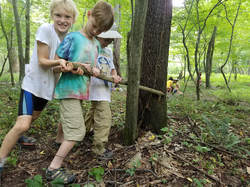How to build and light a 1-match fire structure
Notice that the firewood (collected in the video below) has been broken into pieces and organized into bundles by thickness.
In this example I dug a trench under the first bundle, but you can also elevate one side of the bundle -- these methods allow you to place a match or tinder under your kindling, and for the fire to get more air.
In this example I dug a trench under the first bundle, but you can also elevate one side of the bundle -- these methods allow you to place a match or tinder under your kindling, and for the fire to get more air.
Collecting branches for a 1-match fire (spice bush)
Notice that each branch I collect has lots of thin twigs, and that I gather a sizeable handful of branches.
What wood to collect?
You may not have access to spicebush like I do in the videos above.
But I find that bushes and vines in general tend to have thin and often less dense twigs compared to trees -- this makes them more flammable, but also burn quickly and produce less heat.
In our region greenbriar is an excellent kindling, and mountain laurel twigs too.
But if you arrange the material as I do in the video on top, you can use them of them to light longer-lived fuel.
Some species of trees also have very thin twigs that work well. I like red maple, birch, red cedar, dogwood and black cherry.
In damp conditions sassafras is exceptional.
For low smoke fuel, beech, maple, hickory, tulip and ash are some of the best in our area.
But I find that bushes and vines in general tend to have thin and often less dense twigs compared to trees -- this makes them more flammable, but also burn quickly and produce less heat.
In our region greenbriar is an excellent kindling, and mountain laurel twigs too.
But if you arrange the material as I do in the video on top, you can use them of them to light longer-lived fuel.
Some species of trees also have very thin twigs that work well. I like red maple, birch, red cedar, dogwood and black cherry.
In damp conditions sassafras is exceptional.
For low smoke fuel, beech, maple, hickory, tulip and ash are some of the best in our area.
Collecting twigs and fuel in winter - 5 ways to tell it's dead
Let's not mutilate our trees and shrubs!
I like to gather dead twigs by breaking them off live plants and shrubs, because they tend to be drier and less rotten compared to twigs on the ground.
But when you first start out, it will be hard to tell which twigs are dead when the leaves are all south for the winter. Breaking off live twigs damages the plant, and these twigs don't burn well because they are saturated with water.
Tips for telling apart live from dead twigs.
Flexibility
Live branches to tend to be very flexible, and may bend considerably without breaking. In such a case stop trying to break the branch, it's probably alive! Either look for a different branch, or use the methods below to confirm it's dead before breaking it. On many hardwood species, recently dead branches may also be difficult to break off, especially if it's thicker than a pencil. This recently dead wood will not light as easily, but will produce more heat overall than wood of the same species that has started breaking down already.
Lip test of temperature
In cold weather, live twigs will feel colder when you touch them, especially to your lip, which is more sensitive than fingers - and especially cold or gloved fingers. This works best if the bark is thin on the twig. Also, after breaking a twig, if you are unsure -- touch the broken end to your lip. By contrast, dead dry twigs should feel almost warm, and not particularly cold when you handle them, or touch them to your lip.
Branch posture
A healthy branch on most trees and shrubs has a certain angle that is normal for that plant. After dying and drying out, the branch may start curving downward toward the ground more so than the healthy branches.
Buds
Live branches will have buds, which will grow into flowers or leaves in the spring. Branches without buds are usually dead branches.
Bark condition
Depending on the species and how long the branch has been dead, the bark may be less glossy, cracked, flaking off, shriveled-looking, or otherwise abnormal.
I like to gather dead twigs by breaking them off live plants and shrubs, because they tend to be drier and less rotten compared to twigs on the ground.
But when you first start out, it will be hard to tell which twigs are dead when the leaves are all south for the winter. Breaking off live twigs damages the plant, and these twigs don't burn well because they are saturated with water.
Tips for telling apart live from dead twigs.
Flexibility
Live branches to tend to be very flexible, and may bend considerably without breaking. In such a case stop trying to break the branch, it's probably alive! Either look for a different branch, or use the methods below to confirm it's dead before breaking it. On many hardwood species, recently dead branches may also be difficult to break off, especially if it's thicker than a pencil. This recently dead wood will not light as easily, but will produce more heat overall than wood of the same species that has started breaking down already.
Lip test of temperature
In cold weather, live twigs will feel colder when you touch them, especially to your lip, which is more sensitive than fingers - and especially cold or gloved fingers. This works best if the bark is thin on the twig. Also, after breaking a twig, if you are unsure -- touch the broken end to your lip. By contrast, dead dry twigs should feel almost warm, and not particularly cold when you handle them, or touch them to your lip.
Branch posture
A healthy branch on most trees and shrubs has a certain angle that is normal for that plant. After dying and drying out, the branch may start curving downward toward the ground more so than the healthy branches.
Buds
Live branches will have buds, which will grow into flowers or leaves in the spring. Branches without buds are usually dead branches.
Bark condition
Depending on the species and how long the branch has been dead, the bark may be less glossy, cracked, flaking off, shriveled-looking, or otherwise abnormal.
Finding and processing good fuel wood
Learning to efficiently collect and process good firewood is a very important and practical skill! Not just for survival, but whenever you have a campfire.
Recognizing good fuel wood
Good fuel wood has been dead long enough to be mostly dry inside, but not so long that it has rotted much. If the wood is crumbly, covered in fungus, feels soft or damp on the inside (when you break it), then keep it out of the fire (unless you're trying to create lots of smoke).
Quality firewood will usually break with a sharp snap, or with a dry splintering. If it's not obvious from the sound and appearance, you can touch the inner wood that has been exposed after you've broken it to see if it is damp, soft or crumbly. In cold weather, touch it to your lip for better sensitivity.
With practice, you will become good at recognizing quality fuel by the appearance of the bark.
Where to find good fuel wood
If it hasn't rained in weeks, especially in warm weather it may be that all dead wood you find will burn well (crumbly, rotten or punky wood will still be smoky though).
In normal (semi-damp) conditions of the eastern seaboard, I usually avoid wood laying on the ground, as it usually has absorbed water from the moist earth.
Instead I scan for standing dead trees and bushes, or for dead branches still attached to the parent tree. I also look for branches that are suspended off the ground, caught on other branches or otherwise with minimal ground contact.
Good branches for fuel wood will range from finger to arm thick, and usually from 3' to 8' long.
Efficient collection
It's good practice to avoid collecting fuel in the immediate vicinity of your regular camp. It's preferable to haul it in as you come back from exploring or foraging, and save the most convenient wood for emergencies/back up.
Even a small child can haul a surprisingly large branch considerable distance, dragging it on the ground.
An adult should be able to haul a large bundle of big branches.
Recognizing good fuel wood
Good fuel wood has been dead long enough to be mostly dry inside, but not so long that it has rotted much. If the wood is crumbly, covered in fungus, feels soft or damp on the inside (when you break it), then keep it out of the fire (unless you're trying to create lots of smoke).
Quality firewood will usually break with a sharp snap, or with a dry splintering. If it's not obvious from the sound and appearance, you can touch the inner wood that has been exposed after you've broken it to see if it is damp, soft or crumbly. In cold weather, touch it to your lip for better sensitivity.
With practice, you will become good at recognizing quality fuel by the appearance of the bark.
Where to find good fuel wood
If it hasn't rained in weeks, especially in warm weather it may be that all dead wood you find will burn well (crumbly, rotten or punky wood will still be smoky though).
In normal (semi-damp) conditions of the eastern seaboard, I usually avoid wood laying on the ground, as it usually has absorbed water from the moist earth.
Instead I scan for standing dead trees and bushes, or for dead branches still attached to the parent tree. I also look for branches that are suspended off the ground, caught on other branches or otherwise with minimal ground contact.
Good branches for fuel wood will range from finger to arm thick, and usually from 3' to 8' long.
Efficient collection
It's good practice to avoid collecting fuel in the immediate vicinity of your regular camp. It's preferable to haul it in as you come back from exploring or foraging, and save the most convenient wood for emergencies/back up.
Even a small child can haul a surprisingly large branch considerable distance, dragging it on the ground.
An adult should be able to haul a large bundle of big branches.


